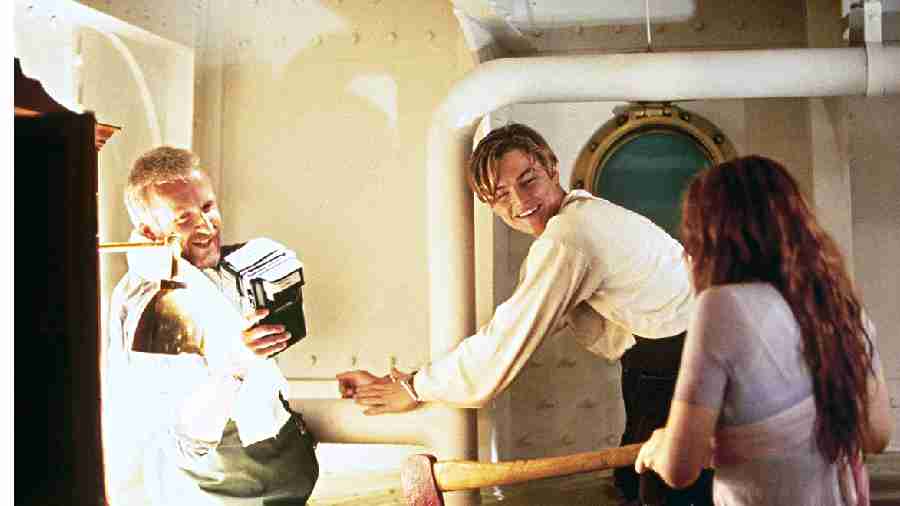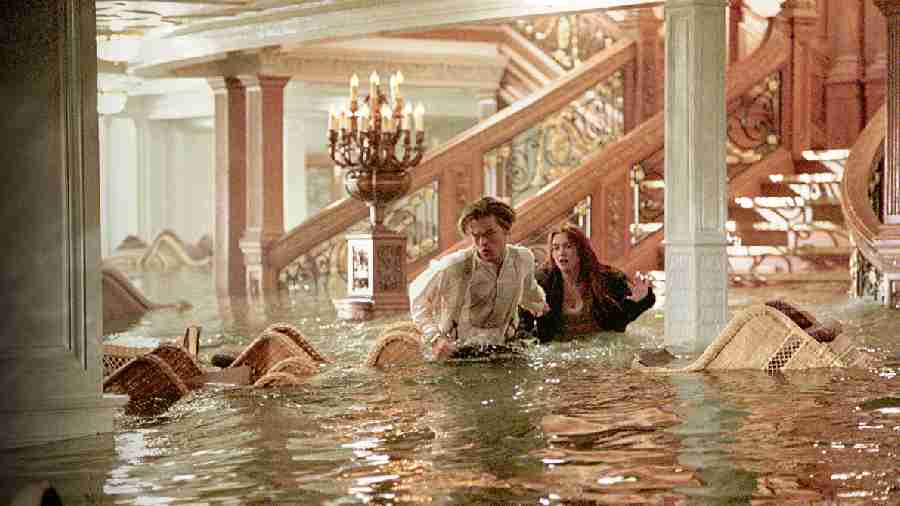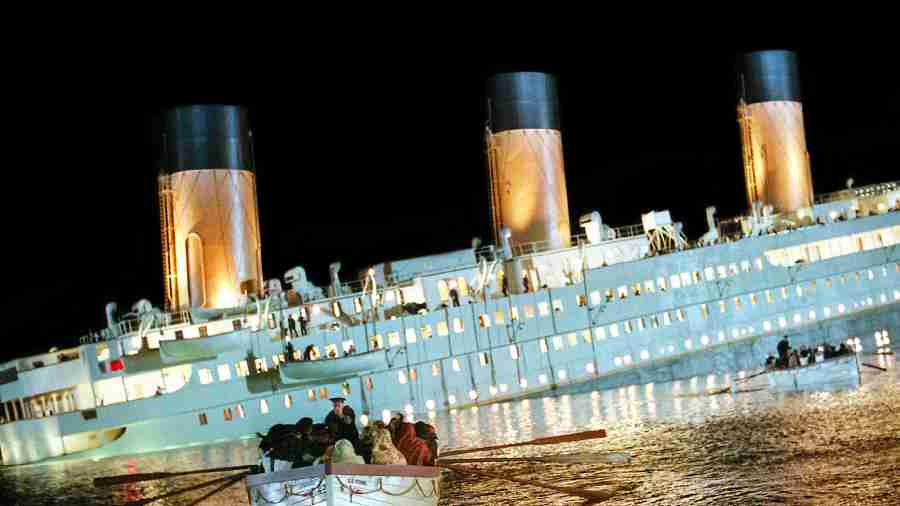A quarter of a century ago, a film merged fantasy with reality, setting an imagined love story, deeply alive and at the end, deeply tragic, against the backdrop of a real-life disaster, and gave us a film that not only became one of the biggest blockbusters in the history of cinema, but continues to remain relevant through the generations.
James Cameron may have given us seminal films like Terminator and Aliens before and the humongous Avatar franchise later, but there is something special which he brought to Titanic — a doomed romance on the surface but packing in themes like female subjugation and the disparity between the haves and have-nots beneath its layers — which not only gave us breakout stars like Leonardo DiCaprio and Kate Winslet, but also afforded a new idiom to the technique of film-making in terms of scale and spectacle.
Titanic remained the highest-grossing film of all time until Cameron’s next film, Avatar, surpassed it 13 years later. A 3D version of Titanic, released in 2012, to commemorate the centennial of the sinking of the ship, drew new crowds who wanted to relive the nostalgia as well as those who had never watched it on the big screen. This weekend, the film has released once more in a remastered 3D 4K HDR render, with high-frame-rate, as part of the film’s 25th anniversary.
To mark the occasion and also to look back at the phenomenon called Titanic, James Cameron engaged with select global media from around the world, including The Telegraph, recently. Excerpts....
Romeo and Juliet on a ship
Even as a youngster, James Cameron, now 68, had always been fascinated by oceans and marine life and had, in fact, worked with the people at Woods Hole Oceanographic Institution in Massachusetts when he was making his 1989 film The Abyss. This was the same institution that had got famous for finding and initial exploration of the Titanic by Robert Ballard, the man who discovered the wreck of the Titanic (which had sunk in 1912) in 1985.
“I met Robert Ballard and I saw all the amazing stuff that they were doing and I started thinking about Titanic,” says Cameron, accompanied by Jon Landau, the producer of Titanic as well as Cameron’s Avatar. Cameron’s ‘eureka’ moment arrived when he watched the docu-drama A Night to Remember, which recounted the final night on the RMS Titanic. “And I thought, ‘Wow, what an amazing backdrop for a love story that would make’,” says Cameron with a smile.
The film-maker pitched the idea to 20th Century Fox, going in with a big book of paintings of the Titanic by Ken Marschall, the famous Titanic artist. “And I flipped it open to the centrefold, which was a big double truck image of Titanic sinking, the lifeboats rowing away, the rockets going off... absolutely gorgeous image. And I said to the head of 20th Century Fox, ‘Romeo and Juliet on that’. And that was it. That was our pitch,” laughs the auteur.
We planted our story on top of what was an already amazing story

James Cameron (left) with Leonardo DiCaprio and Kate Winslet on the sets of Titanic
It’s been more than 100 years of the ship sinking and the 25th year of the film. And yet, the story of Titanic has remained relevant across generations. That’s no mean feat in a world where the audience is constantly bombarded by a plethora of entertainment options, many of which, to be honest, perhaps have more engaging stories to tell.
Cameron believes that, “Titanic has this kind of enduring, almost mythic, novelistic quality. And it has to do with love and sacrifice and mortality. The men stepped back from the lifeboats so that the women and the children could survive. There’s something very elegant about the whole thing. There’s human hubris and the fact that the ship was considered to be unsinkable, but they operated it badly, and it did sink,” opines Cameron, looking thoughtful.
He adds, “But I think it’s that enduring kind of feeling of heartbreak. That feeling of loss and sadness and all of the things combined just make it such an amazing story. We planted our story on top of what was already an amazing story. The two stories, in a sense, elevated each other. I think that because of the movie now, people know more about the history of Titanic because we were very, very accurate in the historical part.”
Despite having an imagined plot set on a ship whose sinking is still shrouded in some amount of mystery, Cameron and his team were careful about “getting the history of it right”.
“We had Don Lynch who was the Titanic Historical Society chief historian as one of our advisors. We went to the actual wreck site and imaged the wreck itself. And we set a bar for ourselves. It was very high for the historical component of it. And I think that has helped remind people down through future generations. We are at one full generation now down from the release of the movie, and I think the movie’s going to be around for a long time, reminding people of that historical story... that real tragedy that happened,” says Cameron, whose latest film Avatar: The Way of Water is still shattering boxoffice record worldwide, more than two months after its release.
What was astounding was the fact that the set that was built was 750ft long, just a little over a 100ft shorter than the real Titanic! “But people have interpreted that incorrectly. They’ve called it a 90 per cent scale miniature.
It’s not! It’s a hundred per cent the scale of the real ship,” says Cameron. “We just took, like, a bread slice out here and a bread slice out there, to kind of shorten it up a little bit. But it’s actually a hundred per cent scale. In fact, we even cast only short-ish extras. So, we made the ship feel even bigger. Yeah. No extras over 5’8” were allowed to be cast. Because all it took is one 6’4” guy to make your whole ship look small!”
The story. The sadness. The beauty. The love
So what makes Titanic — the story, the film, the romance, the tragedy — still watchable enough to merit a re-release every few years? Cameron has a well-thought-out response to that. “I think there are a lot of reasons, and there are a lot of reasons for different people. Let’s take young women, for example. A lot has been made of Leonardo DiCaprio’s appeal. Okay, I’ll grant you $100 million of our box office for Leonardo DiCaprio’s appeal to 14-year-olds,” laughs Cameron.
“What I think was really happening is that young women are at a point in their life where they’re being told by society not to be who they are. Not to be the amazing, unlimited people that they really are and they are being told to sit down, shut up, pull in that corset and do what society expects... do what male-dominated society expects. This was a movie about Rose, Kate Winslet’s character... her fulfilment as a person,” says the film-maker.
He agrees that Jack, played by DiCaprio, was undoubtedly “a catalyst for her, but she went on, having survived Titanic to live a full life.
She realised her full potential. And I think that speaks to the female side of the audience, and men who care about such things, which I do as a father of daughters”.
And then, of course, was the heartbreak, the sadness and the beauty. “The love. The beauty of the love story that culminates tragically. You can have a rom-com and they can kiss at the end and go off into the sunset. But there’s something much more powerful about a love story that has loss and separation in it. And of course, there’s no separation more permanent than death,” says Cameron, summing it up succinctly.
Many stories on and studies of Titanic, since its release, have focused on the ending when Rose, now an old woman of 103 and played by the redoubtable Gloria Stuart, is shown closing her eyes in bed, with the scene cutting to her, now as young Rose and played by Kate Winslet, reuniting on the ship with Jack where they share a dance and kiss. Cameron addresses the question, or does he?
“Is it in an afterlife, or is it just Rose imagining what being reunited with Jack is.... Maybe it’s just a celebration of her memory and the most important thing that happened to her in her life as a very young woman, remembering that at 103 so vividly that she believes that she must someday be reunited with him. So you can have a secular interpretation of that, or you can have a religious interpretation of that. Or a yearning. A kind of spiritual yearning. We all experience love as human beings. I think a lot of the appeal of the film is about the journey that you go on. The beauty, the spectacle, the music, all that,” he smiles, once again leaving it open-ended.
And I said, ‘Lord, just take me now!’

A scene from Titanic being shot
Titanic was made on a massive scale, requiring years and years of research before it went on the floors. Cameron, as expected, has vivid memories of making the film.
“I remember the making of the film almost better than I remember the movie itself, strangely,” he laughs. “The very last day of shooting, the very last shot, I was in a wet suit, scuba gear, and hockey goalie knee pads in the bridge. When we fired off all the squibs and blew in, the water came rushing in. It was a 15-ft head of pressure. There was me and the Polish stunt guy who was playing the captain, who had a spare air rigged up his back and down his arms, so he had a regulator in his hand. And the water in the glass and everything just poured in. Hundreds of tons of water came smashing in. And it was like a punch in the face. I got the shot, and then everything went black. And I remember thinking about all of the trials and tribulations we had in front of us in post-production, getting this movie done. And I said, ‘Lord, just take me now!’ Then they pulled open the hatch, and they pulled us out. We were okay”, he laughs.
We did launch Leo & Kate to the next level
Leonardo DiCaprio and Kate Winslet, of course, became global heartthrobs overnight, and are today Oscar-winning actors with a credible body of work behind them. Did Cameron, working with him as virtual rookies then, foresee what Leo and Kate would eventually become?
“Well, look, Leo’s Leo, and Leo is who we know him to be at the time. What we knew at the time was he was a really, really strong actor, a really gifted actor. And he seemed to have unlimited possibilities. And the same thing with Kate. She has gone on to realise the promise of her early brilliance. When we cast her in Titanic, she was 19. Leonardo was, I think, 20 at the time. And they were each a year older by the time we were done shooting. They were young, but they were both already well on their way. I also think it’s fair for us not to take credit for launching their careers,” says Cameron.
“Leo had already done Romeo + Juliet, which lofted him into that kind of leading man position. And teed up beautifully into Titanic. And Kate had already done a number of really notable performances up to that point. So, we were just lucky to catch them at that exact moment in their career. And I think it’s safe to say we did launch them to the next level,” he adds.

What is interesting is that DiCaprio wasn’t too keen on doing Titanic at first because he didn’t find his role “challenging enough”. “It was misquoted later that I said he thought it was boring. He didn’t think the movie was boring. He thought his part, boring may be the wrong word, was not challenging enough,” clarifies Cameron. “He was looking for challenge. He wanted to have a problem. He wanted to have something to rage against,” adds the film-maker.
It took some convincing from Cameron for Leo to say ‘yes’. “I had to convince him about playing that guy that doesn’t have an obvious problem coming in, who is in fact one who’s the more emotionally mature and adult of the two people. So that the transfer of energy and the love story is from Jack to Rose. And she grows as a result of it. I said that is going to be a harder thing to do. And it’s only when I convinced him of the challenge of his character that he became interested.”
Conversely, it was Cameron himself who wasn’t convinced about casting Kate Winslet as Rose. “I was a little nervous about the fact that she had played in so many period dramas before that. She was getting a reputation of ‘corset Kate’. And the last thing I wanted was ‘corset Kate’ being in a movie where one of the most memorable scenes is her being put into a corset, which was obviously a visual symbol of her being restricted by society and by her family. So, I kind of almost didn’t even want to see her at first. But I met her and she was spectacular,” says Cameron. Thank God for that, we say.
“We cast Kate, and then Kate was very generous with her time in working with our potential Jacks as they came along, including Leo. I could see the chemistry between them. She reiterated that afterwards. And she said, ‘He’s the guy. He’s the guy’.
Making Titanic now
If he made Titanic now, 25 years on, what would he do differently? Cameron is pretty sure he would still tell it as a love story. “I’m sure I would still focus on the emotions. In terms of how we did it, the actual technique, everything is different now. We would’ve used a lot more CG. We would’ve built a lot less set. We would’ve used a lot of CG crowds because we know how to do that now. The end result, I don’t think would be different. Probably not at all. We’d shoot the same script, we’d have the same values and the cinematography would look the same,” he says.










